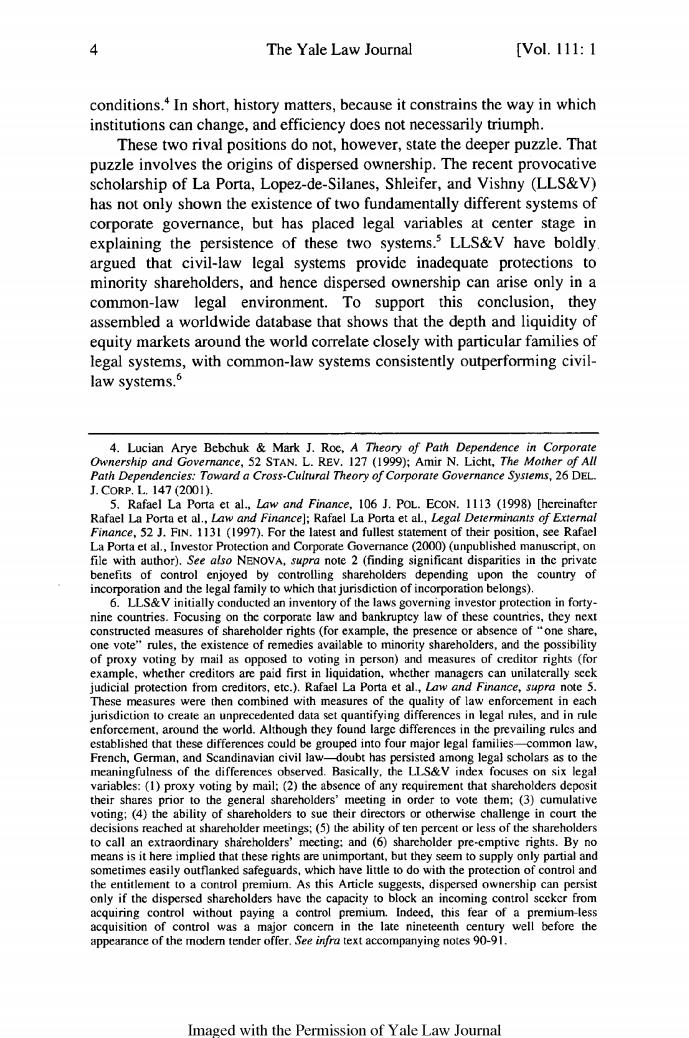正在加载图片...

The Yale Law Journal [Vol.111:1 conditions.In short,histor These two rival positions do not,however,state the deeper puzzle.That puzzle involves the origins of dispersed ownership.The recent provocative scholarship of La Porta,Lopez-de-Silanes,Shleifer,and Vishny (LLS&V) has not only shown the existence of two fundamentally different systems of corporate governance,but has placed legal variables at center stage in explaining the persistence of these two systems.3 LLS&V have boldly. argued that civil-law legal systems provide inadequate protectionsto minority shareholder s,and hence dispersed ownersh p can e only in a common-law legal environment.To support this conclusion, they assembled a worldwide database that shows that the depth and liquidity of equity markets around the world correlate closely with particular families of legal systems with common-law systems consistently outperforming civil- law systems 4.Lucian Arye Bebchuk&Mark J.Roc.A Theory of Path Dependence in Corpora 2001 Rafael La Port nts of Ert 113l(99 )For the st and fullest00)( on,see F file with author).See also NENOVA.supra note 2 (finding significar t disparities in the priva inc s and the on the dernghis(iorcxmpe the pr nce or bsence one of proxy voting by mail as op I to otin in erson)and me asures of credit ese me were then of he in ea enforcement.around the world.Although they found larg differences in the prevailing rules a o the s of th that he the hareh vote th :(3)cun (5)the abil of ten ent c ng:and《 th an ke little to do h the pr of control an only if the dis out paying a control appearance of the modem tender offer.Seenr text accompanying notes9-91 Imaged with the Permission of Yale Law JournalThe Yale Law Journal conditions.4 In short, history matters, because it constrains the way in which institutions can change, and efficiency does not necessarily triumph. These two rival positions do not, however, state the deeper puzzle. That puzzle involves the origins of dispersed ownership. The recent provocative scholarship of La Porta, Lopez-de-Silanes, Shleifer, and Vishny (LLS&V) has not only shown the existence of two fundamentally different systems of corporate governance, but has placed legal variables at center stage in explaining the persistence of these two systems. 5 LLS&V have boldly argued that civil-law legal systems provide inadequate protections to minority shareholders, and hence dispersed ownership can arise only in a common-law legal environment. To support this conclusion, they assembled a worldwide database that shows that the depth and liquidity of equity markets around the world correlate closely with particular families of legal systems, with common-law systems consistently outperforming civillaw systems. 6 4. Lucian Arye Bebchuk & Mark J. Roe, A Theory of Path Dependence in Corporate Ownership and Governance, 52 STAN. L. REV. 127 (1999); Amir N. Licht, The Mother of All Path Dependencies: Toward a Cross-Cultural Theory of Corporate Governance Systems, 26 DEL. J. CORP. L. 147 (2001). 5. Rafael La Porta et al., Law and Finance, 106 J. POL. ECON. 1113 (1998) [hereinafter Rafael La Porta et al., Law and Finance]; Rafael La Porta et al., Legal Determinants of External Finance, 52 J. FIN. 1131 (1997). For the latest and fullest statement of their position, see Rafael La Porta et al., Investor Protection and Corporate Governance (2000) (unpublished manuscript, on file with author). See also NENOVA, supra note 2 (finding significant disparities in the private benefits of control enjoyed by controlling shareholders depending upon the country of incorporation and the legal family to which that jurisdiction of incorporation belongs). 6. LLS&V initially conducted an inventory of the laws governing investor protection in fortynine countries. Focusing on the corporate law and bankruptcy law of these countries, they next constructed measures of shareholder rights (for example, the presence or absence of "one share, one vote" rules, the existence of remedies available to minority shareholders, and the possibility of proxy voting by mail as opposed to voting in person) and measures of creditor rights (for example, whether creditors are paid first in liquidation, whether managers can unilaterally seek judicial protection from creditors, etc.). Rafael La Porta et al., Law and Finance, supra note 5. These measures were then combined with measures of the quality of law enforcement in each jurisdiction to create an unprecedented data set quantifying differences in legal rules, and in rule enforcement, around the world. Although they found large differences in the prevailing rules and established that these differences could be grouped into four major legal families-common law, French, German, and Scandinavian civil law-doubt has persisted among legal scholars as to the meaningfulness of the differences observed. Basically, the LLS&V index focuses on six legal variables: (1) proxy voting by mail; (2) the absence of any requirement that shareholders deposit their shares prior to the general shareholders' meeting in order to vote them; (3) cumulative voting; (4) the ability of shareholders to sue their directors or otherwise challenge in court the decisions reached at shareholder meetings; (5) the ability of ten percent or less of the shareholders to call an extraordinary shdreholders' meeting; and (6) shareholder pre-emptive rights. By no means is it here implied that these rights are unimportant, but they seem to supply only partial and sometimes easily outflanked safeguards, which have little to do with the protection of control and the entitlement to a control premium. As this Article suggests, dispersed ownership can persist only if the dispersed shareholders have the capacity to block an incoming control seeker from acquiring control without paying a control premium. Indeed, this fear of a premium-less acquisition of control was a major concern in the late nineteenth century well before the appearance of the modem tender offer. See infra text accompanying notes 90-91. Imaged with the Permission of Yale Law Journal [Vol. I111: 1